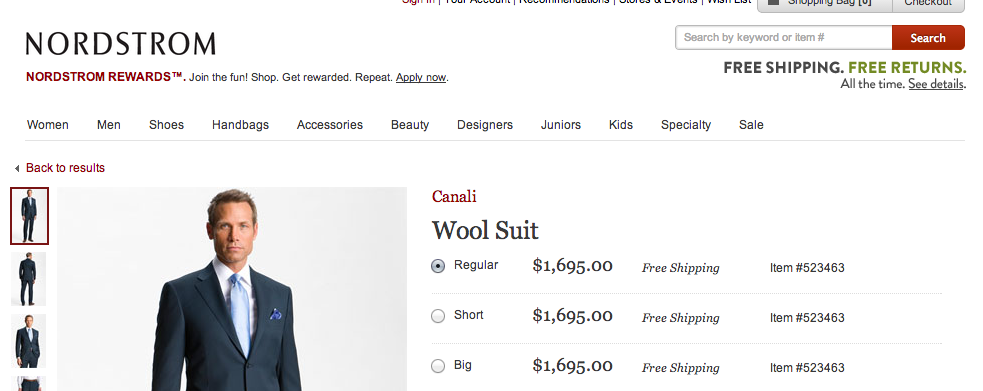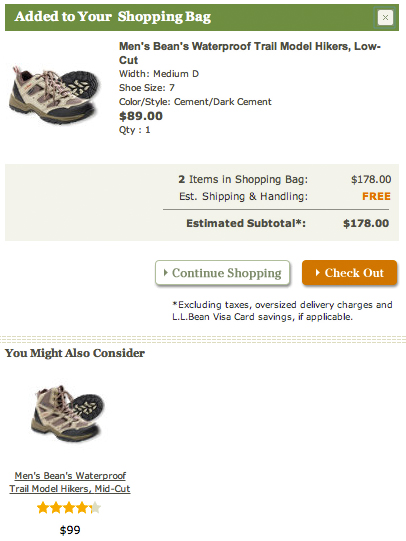What is the impact of upselling in ecommerce?
According to Forrester research analyst Sucharita Kodali, product recommendations are responsible for 10 to 30% of ecommerce site revenues.
Way back in 2006, Amazon reported that 35% of its revenues were a direct result of its cross sales and upsells.
If you want to increase your online sales and don’t have an upselling testing program in place, you need to read this.
Table of contents
What is upselling?
Upselling is a sales technique in which the seller encourages the customer to spend more than they had originally intended. For the purposes of this article, this is by recommending a higher priced alternative to the item the visitor is currently considering.
Many definitions of upselling also lump “add-on sales” or “bundle sales” into upselling, but in order to have an accurate view of what is most effective, I believe it’s important to look at these as entirely separate practices.
Asking a customer to spend an extra $100 to $200 on a more powerful computer—a true upsell—uses a very different written and visual language than than asking customers to buy the extended warranty.
While we’ll be focusing on pure upselling in this article, it’s worth mentioning the other ways of adding more to your average cart value.
What are cross-sales, add-on sales, and bundle sales?
A cross-sell is a technique of suggesting to your customer to buy a product that compliments their existing purchase, but is from a different category or vendor.
Here’s a great example of a cross-sell interstitial by Bold Upsell, an app for Shopify customers.
Add-on sales are the extra little services—like protection plans, tech support subscriptions, or product training—that give your customer the extra peace of mind.
These can significantly increase your customer lifetime value, as many customers don’t need to take advantage of the service and instead buy it “just in case.”
This academic paper by Joseph C. Hartman and Kamonkan Laksana of Lehigh University shows you how to effectively calculate the cost of extended warranties.
It also analyzes various price points, factoring in risk/cost conditions and shows profit increases up to nearly 40%.
Bundle sales is a technique of recommending two or more products that complement each other and making it easy to add them to the cart from the product page or checkout.

Product bundles are often sold at a discount in order to raise the perceived value of buying multiple products at once.
Featuring product bundles can also be used as a traffic acquisition tactic or lead magnet, setting the stage for email marketing, retargeting campaigns, and other customer onboarding campaigns.

Something to be aware of: research by Vineet Kumar of Harvard Business School analyzed handheld game systems, a popular bundle sale item, shows that customers are more likely to buy when both the bundle and the individual products are available.
…when a bundle was the consumer’s only option—a “pure bundling” scenario—Nintendo would fare much worse, when compared with both offers that lacked any bundle as well as those with the mixed bundling option. Revenues decreased by over 20 percent compared with the mixed bundling scenario; the total hardware units sold declined by millions of units; and software units fell by over 10 million as well.
Takeaway: when offering a bundle, make sure customers know the individual products are also for sale.
Note: for upsell guidelines and tons of other tips for ecommerce, see our comprehensive ecommerce best practices (more specifically, 247 ecommerce guidelines for design and optimization).
The opportunity for “pure upselling” and why it’s so effective
The only way to know for sure what revenue boosting strategy will result in the most profit for your specific business is to test it.
However, a study from PredictiveIntent has shown that displaying slightly higher priced options than those in your visitors immediate view drives an average of over 4% of sales, 20 times more than the standard “recommended products” option found on most ecommerce sites.
Techniques our clients are adopting include incorporating the customer ratings of products when they are being presented, and clearly separating out what are ‘upsells’ and what are ‘cross-sells.’ (Paul Rouke, Prwd)
While it may seem counter-intuitive that you can increase sales by recommending more expensive options, keep in mind we’re talking about tapping into a relatively small portion of your visitors (just over 4%) who aren’t quite sure they’re getting the exact right thing—or only want the very best.
Part of this buyer’s mindset has to do with the indecision associated with choice, and part of it is related to the Monty Hall Problem.
1. The indecision of choice
People’s ability of making rational decisions when presented with multiple options has been a joke as far back as 350 BC when Aristotle wrote:
…a man, being just as hungry as thirsty, and placed in between food and drink, must necessarily remain where he is and starve to death.
From buying jam, to reducing form fields, to multiple images in a slider, to various options on a homepage—presenting your prospect with too many choices can be paralyzing, often resulting in no choice being made at all.
As more information becomes available, decisions are even harder to make as evidenced by Google’s Zero Moment of Truth report. It showed that shoppers doubled their information consumption from 2010 to 2011, and doubled again from 2011 to 2012 to nearly 18.4 different pieces of content.
Research by Cisco also found that 78% of shoppers are using the internet to research their purchases and make sure they’re getting the most value out of their decision.
Which leads me to the next reason why presenting higher priced alternatives may lead to an increase in sales.
2. The Monty Hall problem
In 1963, American television show, Let’s Make A Deal, presented contestants with an opportunity to win a new car if they picked the right door.
Behind one door would be a brand new car, and behind the other two—a goat.
After a contestant picked a door, the host would open another door which has a goat behind them. Then, contestant would be asked if they’d like to stick with their original decision or switch doors.
Figuring there was a 50/50 chance they picked right the first time, most stuck with their original decision, claiming “I would never forgive myself if I switched and ended up with the goat.”
Mathematically speaking though, the odds are always in favor of the switch.
Most people will stick with their original decision—whether it’s a door, or a product on an ecommerce site—even though it’s probably wrong, due to a psychological bias known as the overconfidence effect. It’s the same reason why 93% of Americans believe they’re above-average drivers.
Looking at PredictiveIntent’s research another way, you see we’re only talking about 4.25% of your customers—a relatively small portion—will be inclined to “switch,” and that decision can be very profitable for you.
Think of it this way. If the average customer has already looked at 18 sources of information before committing to a purchase, by the time they’ve hit the product page, it’s like they’re picking door #1.
Their research helped them eliminate door #2, a product they figure is not right for them, before they ever reached the page.
So while they’re looking at door #1, mostly sure they’re making the right decision, right there they see door #3, a product with better features, better testimonials, and better ratings…
…and it’s only X amount of dollars more… (Damn it, I deserve it!)
Research has shown that cost isn’t always the most important factor, emotion plays a significant role in purchase decisions, and that 52% of online shoppers felt that online reviews have the most influence on what they buy.
Even though the PredictiveIntent research shows that 95.75% of your customers are still going to stick with their original purchase, how significant would 4.25% of your customers spending an extra $20, $50, or $100 be for your bottom line?

If a single product averages 1,000 customers/month, that means you’d be adding an extra $860 to $4,300 to sales every month. By the end of the year, that’s an additional $10,320 to $51,600 on a single product.
Not bad, right?
Bonus: PredictiveIntent’s research also showed that displaying cross-sells at checkout increased sales by another 3%.
What do you upsell? Analyze your customer’s purchase behavior
The question then becomes: what products should you be upselling?
In many cases, displaying the “next model up” is a perfectly reasonable option.
Why get the 30-day supply when the 60-day supply is $20 more but will last twice as long? Why get the 49″ television, if the 55″ is bigger and only €180 more?

Pricing experiments have already shown us that this is kind of the rationale that goes through customer’s minds. As long as you’re not obnoxious about the way you upsell, it’s not unreasonable to offer a higher price model.
However, a better way to upsell is when the recommendation puts your customer into the product that’s the best fit for their needs.
Take this WinZip Cart upsell for example:
The offer provides a very clear savings advantage (20%) as well as lists additional features—like data backup, zip-from-camera capability, and CD burning—for an extra $10, that could end up saving a lot of time for someone like a professional photographer.
This example by L.L Bean is okay, though I would like it better if they would add something like “Perfect for Hiking In The Mud” to add more context to why I should buy mid-cut as an alternative to the low-cut shoe.
The product selection page for iPad Air does an ok job here too.
By showing the option to get Wi-Fi + Cellular, visitors know they don’t have to be confined to Wi-Fi areas, but adding a quick line about “always being on the go” might make it easier for high-travel tablet users to identify themselves, rather than justifying buying a lower model because “there’s Wi-Fi everywhere.”

Even though it’s a step before you reach the product page, the Microsoft Surface 2 provides additional context as to why you should consider the 4G LTE model when you purchase their tablet.
Adding that little extra, like “Do more on the go” or “for serious photographers” or some other copy targeting power users, can add so much more context as to why you’re “recommending” a product.
If you’re manually uploading your upsells and not currently using some kind of personalization software, look at the higher priced models (and alternatives) that sell well or get better reviews as a starting place for your upsell offer.
Once you know what you’re upselling, use an A/B testing tool to determine which upsell offer is going to be the most profitable for you.
But you absolutely should use automated upselling
The trouble with manually entering your upsell items is that it’s impossible to scale, and it will never adapt to your customer’s browsing behavior.
This is the exact reason why headphone retailer SkullCandy switched from Google Analytics to Adobe Marketing Cloud. Despite a small dip in traffic, they were able to increase upsell revenue by 30%.
Switching from manually configured recommendations to Adobe Recommendations increased upsell revenues by 30%. Plus, it saves us time. Optimizing recommendations used to take about 10 hours a week. Now it takes just half an hour, which frees up staff to do other important work.
Similar stories are reflected on personalization provider 4-Tell’s case studies, where clients see anywhere between 29-70% lifts in revenue and cart value.
Tools for the job
There are a number of tools you could use for this, many of which have already been mentioned throughout the article. However, here are a few I recommend:
- Conductrics: Real-time optimization combined with machine learning to understand visitors behavior and optimize itself to serve the most profitable recommendations.
- Adobe Marketing Cloud: Full-featured solution that enables product upsells, multi-channel analytics, remarketing, and more.
- Marketo: Another solution that enables personalized upsells. Also included is personalized email, ad spend optimization, and a host of other features.
- Evergage: Software suite that focuses more closely on personalization and optimization of ecommerce websites without extra features offered by full blown marketing suites like Adobe Marketing Cloud or Marketo.
Conclusion
Today’s customers are smart and know when you’re trying to squeeze more out of their wallet.
What it all comes down to is value. Helping your customer to get exactly what they want without compromise and feel good about it not only makes you more money, it makes them happier in the long run.
That means offering personalized experiences, relevant recommendations, and products that truly are worth spending a little extra on.



















This will help a lot with my ecommerce customers. You have helped our company tremendously with your posts and insight. By using your conversion techniques, we have helped our clients tremendously. One client has went from 0.5% conversion ratio to 10.81%. Thanks Peep and keep up the good work, you are much appreciated.
Wow Randy! That is incredible :-) Happy to help.
One of the best things I have found with clients is to attach some sort of email drip campaign that targets a customers previous purchases by including potential add-ons and cross sales.
Also, if your customers are purchasing a product that has a direct upgrade or product refresh, putting them on a list that will start to market the “new model” to them in a year or so is also a great way to capitalize on repeat business.
I love the direct upgrade list, that also explains why I keep buying the same damn phone every year – even though it’s just a little faster & a little sharper & a little thinner :-P
I’m glad you brought that up, as this article was really intended to focus on the up-sell on the product page, that goes into the post conversion process very nicely.
Maybe you’d like to write an article on that for us?
Awesome roundup.
Great to see that the original research I did at PredictiveIntent was useful!
Very useful!
Thanks for putting it out there. Have you found anything interesting since?
Thanks for the shout-out of 4-Tell! We think there are many advantages to personalized product recommendations that benefit both the shopper in helping them find what they’re looking for and, of course, the merchant by increasing conversion and sales.
An interesting secondary benefit to the shopper is recommendations offer an alternative form of navigation of the website. We often hear from our customers that their customers (aka the shoppers) “didn’t know they sell X, Y or Z” until the recommendations helped them to discover these hidden gems.
Tommy, it’s an interesting post with great examples!
I’ve included the product recommendation statistics in one of my posts. Take a look here. http://unbxd.com/blog/11-ways-generate-conversions-ecommerce-site/
Thanks!
Great article. Do you have any insight into whether upsell’s cause cannibalization?
Hi Tommy! It’s not the first article written by you I have read and what I can say is your articles are brilliant stuff for anyone who works in online marketing area.
I must say I’ve learned more from your articles than I did during my marketing university studies from Romania. Thank you again and again and keep it in this way!
Have a nice 2015 year and I wish you all the best!
Very informative post about conversion rate optimization! A post about after-sale optimization would be great to read too!
Any ideas on which company offers a website builder AND one click upsell capabilities?